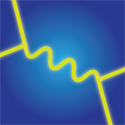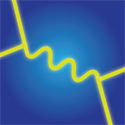Producing top quarks one at a time
Top quarks are most often produced in pairs via gluons, the carriers of the strong force. Such pairs were first observed at Fermilab in 1995. But single top quarks can also be produced via an electroweak process involving a boson and a bottom quark. This process is sensitive to the top-bottom quark mixing parameter known as and the rate at which it occurs provides new information about the top and bottom quarks. (The top and bottom quarks form a third generation of quarks, added to the first generation, up and down quarks, and the second generation, charm and strange quarks.) Measurements of single top quark production can therefore constrain extensions of the standard model, such as those with a fourth generation of quarks.
Single top quark events are more difficult than top quark pair events to pick out of the vast number of background events. The first evidence for single top quark production was reported only recently by the Fermilab experiments, in 2006 for the D0 experiment and 2008 for the CDF experiment, with a statistical significance of 3.4 and 3.7 standard deviations, respectively. Since that time, both D0 and CDF have taken more data and improved their multivariate analyses. In a pair of papers appearing in Physical Review Letters, they now claim to have definitively observed single top quark production, each at the 5.0 standard deviation level. They also put constraints on , which agree with what the standard model predicts.
In the future, Fermilab, and later the LHC, will accrue more single top quark events and constrain further, which will either help to confirm the quark mixing picture of the standard model, or point to new physics. – Robert Garisto





